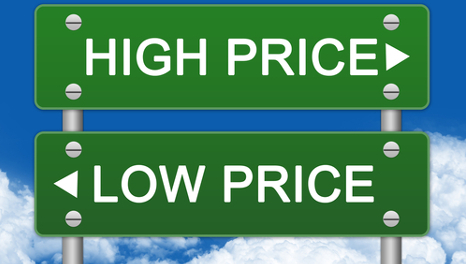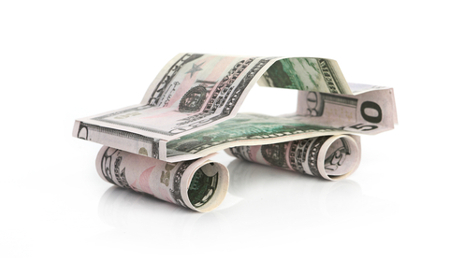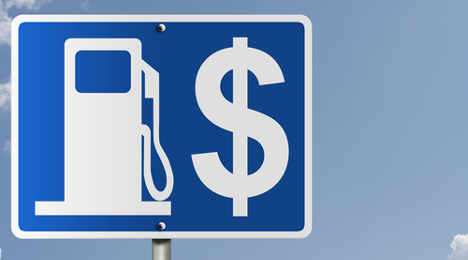The data makes one thing fairly clear about incentive spending: it’s substantial these days.
But how are incentives really impacting used-car values? And is elevated spending enough to cause a panic?
NADA Used Car Guide’s Jonathan Banks and Larry Dixon took a close look at the impact of incentive spending — plus a multitude of other factors that play a role in used-car pricing — during a presentation at Used Car Week's National Remarketing Conference titled “Used Vehicle Market: Impending Collapse or Continued Success.”
Given how the spike in new-car sales has evened out a bit, OEM incentives have been ramped up, approaching some of the highest levels in history, the NADA analysts noted.
Third-quarter incentives were up 18 percent year-over-year, with spending moving to a level not seen since 2004 when the market was awash with incentives, according to NADA.
Automakers have scaled back on cash incentives from a decade ago, they noted, but they are still putting record or near-record amounts on finance and lease subvention.
And according to the latest Guidelines report from NADA Used Car Guide, October was the 21st straight month of annual gains in incentive spending — and specifically, spending for the month was north of $2,700 per unit, a 5.7-percent year-over-year spike, NADA said, citing Autodata Corp.
Through 10 months of 2014, incentive spending is up 8.4 percent over the year-ago period, NADA indicated in the report.
But here’s an important caveat as it relates to used-car prices, as noted by Banks in the Guidelines report.
“Manufacturer incentives likely played less of a role in dampening used prices in October than in the prior three months. On average, spending grew by 5 percent compared to October 2013 according to Autodata data,” Banks said.
“This is down sharply from the 18 percent annual rate of growth recorded in the third quarter,” he continued. “After having risen by an average of 5 percent over the preceding five months, incentives for 2014 models fell by just over 1 percent compared to September, while automakers pulled spending back by an even steeper 8 percent on 2015 models.”
Banks also emphasized that the share of total new-vehicle sales from the 2015 model-year crowd was at 48 percent in October, versus 32 percent in September.
And here’s a big takeaway from Banks’ and Dixon’s presentation at NRC.
Yes, elevated incentive spending — along with stronger supply and weakening credit conditions — are likely to have a downward impact on used-car pricing.
However, there is something these developments and other concerns are met with: a more robust economy and the paradigm shift the industry has gone through recently, they said.
Specifically, NADA is projecting a 2.2-percent year-over-year drop in used-car prices for the fourth quarter. Further out, it expects Q4 2015 used prices to fall another 5 percent from Q4 2014.
Such a decline would result in used prices about 3 percent stronger than 2010 levels.
And this, NADA said, is fairly acceptable given how much strength and growth used prices have seen in recent years.
As dealers and buyers started gearing up for Black Friday sales promotions last week, price trends in the lanes were “interesting,” to say the least, said Black Book’s Ricky Beggs.
The editorial director noted in his latest “Beggs on the Used Car Market” video that prices in the auction lanes were described as “all over the board” last week.
With over 1,875 vehicles adjusted for price each day last week, trends began fluctuating a bit.
For example, the $84 decline for the car segments was the largest decline seen over the past eight weeks.
On the other hand, the trucks saw the lowest level change over the past five weeks with a $42 average decline.
“The trucks have been better performers with the lower depreciation than the cars over the past few months,” Beggs said.
The full-size vans were one segment, in particular, to see strong price retention in the lanes this past week, posting a slight increase.
And the full-size pickups continue to perform well with a slight decline of only $12. This marks the smallest decline for this segment over the past six weeks.
And the large utility segments, though they continue to see larger-than-average declines, saw prices bounce back a bit this past week.
The declines of $55 for the full-size SUVs, $87 for the full-size crossovers, and $55 for the luxury SUVs, are the lowest declines seen for each of those large utility segments over the past seven, five, and six of the previous seven weeks, respectively, Beggs reported.
“The pickups and full-size vans are probably being driven by an improving economy along with the construction/service industry,” said Beggs. “The full-size utilities could be driven by the favorable gas prices which fell another 5 cents at the pump this past week to $2.89 a gallon, 33 cents below one year ago.”
See the latest "Beggs on the Used Car Market" video report above.
Used prices remain elevated — the second quarter holds the record for highest used prices in history, and Q3 was the highest third quarter on record — and analysts are narrowing it down to two factors the industry expects are behind this trend.
According to the Q3 2014 Used Vehicle Market Report from Edmunds.com, it comes down to one, the fact that used vehicles being sold are younger; and two, low gas prices making large vehicles more attractive.
But first, let’s get down to the bottom of it — and that may have to do with age.
One of the main reasons behind the recent spike in price, Edmunds.com asserts, is used vehicles in the lanes and on the lots are simply younger.
Due mostly to an increase in lease returns — units which are often only 1 to 3 years old — Q3 had seen a higher level of newer used vehicles.
According to the report, one out of five used vehicles sold in 2014 were between 1 and 2 years old.
In comparison, this rate had dropped down to 14 percent in Q3 2013.
“This higher mix of newer used vehicles has led to an upward pull of used car prices,” Edmunds.com analysts said.
The second factor pushing high used prices, is low gas prices, which are pushing more consumers to buy larger vehicles — which, of course, are often more expensive.
“The U.S. is experiencing record low gas prices with 2014 marking the fourth year in a row that fuel costs have stayed within $3 per gallon,” the report stated.
Edmunds analysts contend this trend has causes many of the light truck segments to experience sizable gains in used values as car shoppers are willing to purchase them again.
“These are generally larger vehicles which command a higher price tag,” analysts pointed out.
The Edmunds report offered this example: the midsize traditional SUV category saw prices lift by a significant 18.7 percent year-over-year in Q3.
“These vehicles saw so much contraction during the recession that many analysts predicted their exit from the market, however, stable fuel costs and increasing niche market demand has these vehicle’s transacting nearly 19 percent higher than 2013 Q3,” Edmunds.com analysts explained.
For comparison, take a look at one of the smaller, more fuel-efficient segment’s price movement. The compact car segment, for example, only saw a 2.1-percent year-over-year price spike in Q3.
The Baltimore Ravens are on the cusp of winning Super Bowl XLVII. President Barack Obama is being sworn into his second term. Most of us (for better or worse) have yet to hear the song “Blurred Lines.”
That was January 2013. It was also the last time that vehicle incentive spending did not show annual growth.
According to the latest Guidelines report from NADA Used Car Guide, October was the 21st straight month of annual gains in incentive spending — and specifically, spending for the month was north of $2,700 per unit, a 5.7-percent year-over-year spike, NADA said, citing Autodata Corp.
Through 10 months of 2014, incentive spending is up 8.4 percent over the year-ago period, NADA indicated in the report.
But here’s an important caveat as it relates to used-car prices, as noted earlier in the report by Jonathan Banks, NADA Used Car Guide senior director of vehicle analysis and analytics.
“Manufacturer incentives likely played less of a role in dampening used prices in October than in the prior three months. On average, spending grew by 5 percent compared to October 2013 according to Autodata data,” Banks said.
“This is down sharply from the 18 percent annual rate of growth recorded in the third quarter,” he continued. “After having risen by an average of 5 percent over the preceding five months, incentives for 2014 models fell by just over 1 percent compared to September, while automakers pulled spending back by an even steeper 8 percent on 2015 models.”
Banks also emphasized that the share of total new-vehicle sales from the 2015 model-year crowd was at 48 percent last month, versus 32 percent in September.
The auction lanes are showing signs of a mid-fall market, which is manifesting through more stable price movement and waning interest in some of the sportier vehicles.
Ricky Beggs, Black Book editorial director, highlighted this seasonal market in his latest “Beggs on the Used Car Market” video report.
Beggs reported, “Consistent overall average segment changes this past week, that are very close to the average segment change since the first week of October, indicate a steadily trending market.”
One sign of a steadier market after the heavy price declines of October — Black Book editors made 1,886 price adjustments on average each day last week, and 28 percent of those changes were increases.
This marks the largest percent of price increases for adjustments since the beginning of July.
The car segments fell an average of $67 last week, which is just under the average decline of $72 for the past seven weeks, also showing steady trend lines in pricing movement.
The premium sporty cars took the biggest hit, with prices falling by $119. This segment has seen drops of over $100 for the past 11 out of 12 weeks.
“It is the fall and heading into winter, not the most exciting time to have a high level sports car on your lot for speculation,” Beggs said, not surprised by this movement.
With gas prices at an average $2.94 per gallon, it is also important to point out four of the five most fuel efficient car segments Black Book tracks have been remaining stable as far as depreciation goes.
Normally, lower gas prices mean lower rates at auction for the more fuel efficient units as consumer interest shifts.
Last week, four of the five more fuel efficient car segments had depreciation of 0.57 percent to 0.84 percent, as compared to the 0.76- percent overall drop for the cars, Beggs pointed out
“This is the first time with low gas prices that the change has been at that level of decline consistently for the more fuel efficient cars,” he said.
The truck segments have also remained steady as far as depreciation goes.
Last week, the trucks saw prices fall by an average of $51, which is in line with the seven week average decline of $48.
The compact and midsize pickups were two of the best performing truck segments, with a drop of $14 and a rise of $2, respectively.
“We feel this is as much a low supply effect as anything,” Beggs said of the compact and mid-size pickup price retention trends.
The full-size pickups, though touting a larger decline of $79, are seeing consistency in the lanes, as well, in line with the four-week average drop of $73.
The full video can be seen above.
After falling by 3.7 percent in October, according to NADA data, wholesale price drops are expected to be a bit milder the rest of the year.
According to NADA's November edition of Guidelines, depreciation normally becomes more moderate from November through January before tax season sparks the usual spring spikes
This month, NADA expects depreciation to slow to a rate of 2.5 to 3 percent before lowering to roughly 1.5 percent in December.
This is a bit higher than last year’s depreciation of 1.8 percent and 1 percent, respectively, in November and December 2013.
As for what segments will see the biggest losses this month, NADA says trends will remain consistent.
For example, depreciation is expected to be the most severe among the mid-size vans, sub-compact and compact cars, and luxury cars.
“Depreciation for the group is expected to be at or above the high end of our forecast,” the report stated.
Mainstream and luxury mid-size cars and compact and mid-size utilities are expected to see price drops ranging from 2.2 to 2.6 percent.
And NADA expects prices for large pickups — which have showed strong retention trends this year — to fall by less than 2 percent this month.
In October, increasing supply and waning demand for late-model vehicles combined to create the perfect storm, putting downward pressure on wholesale prices.
And last month’s 3.7-percent average decline marked the fourth month in a row with depreciation at or above 3 percent.
“In general, segments where the influx of late-model supply has been greatest have experienced the largest declines in prices,” the report stated.
Last month, at the top of this list was the mid-size van segment. NADA reported volume for 2013 and 2014 model year units has nearly tripled since the end of the summer. This has caused prices for the segment to fall by 9 percent over the past two months. Once again, this segment is expected to lead depreciation for November, as well.
Though ADESA’s monthly analysis of used-car prices showed a slight uptick from September, this bump in price may not accurately portray the current environment in the lanes.
According to ADESA Analytical Services’ monthly analysis of wholesale used vehicle prices by vehicle model class, auction prices were up 1.3 percent to an average of $9,678 last month.
But don’t be tricked — ADESA chief economist Tom Kontos says there is more to that story.
“As in September, a large proportion of higher priced, late-model manufacturer off-rental program vehicles, some of which were sold after delays due to recalls, biased average wholesale prices upward and masked the inherent softness of a wholesale used vehicle market facing high incoming supply,” Kontos said.
With more supply coming in, Kontos pointed out retail used-vehicle demand didn’t “support” auction prices as it had in prior months, “as franchised dealers did well simply to retail the many units they have been taking from off-lease purchases and in trade on strong new-vehicle sales.”
In fact, retail used-vehicles sales were down 18 percent month-over-month in October, according to CNW data.
That said, Kontos pointed out franchised dealers saw a 2.2 percent year-over-year spike in used sales, which he says indicates they are having an easy time retailing the trade-ins coming in from strong new-car sales.
And Kontos pointed out strong CPO sales — which, according to Autodata, were up 7.5 percent on a monthly basis in October — are playing a large role in absorbing expanding supply from lease volumes and trade-ins, as well.
This past month’s auction price movement rose year-over-year last month, as well, up 0.9 percent compared to October 2013, according to ADESA data.
Similar to what was seen in September, Kontos said average prices for minivans were up considerably.
“This reflects an increase in the percentage of current and one-year-old models sold in factory sales,” he added.
Minivans saw prices rise 11.3 percent from September and 13.9 percent year-over-year to rest at an average rate of $7,882 last month.
And though prices rose slightly across the board in October, according to ADESA, dealer consigners were the only seller group to see average prices spike.
Dealer consignors saw a 1.4 percent increase in price from September and a 0.7 percent rise from October 2013.
“This bodes well for the wholesale market’s ability to absorb excess dealer trades,” Kontos said.
On the other hand, prices for vehicles remarketed by manufacturers were down 11.3 percent from September and 8.6 percent year-over-year.
And prices for fleet/lease consignors were down 3.7 percent sequentially and 2.2 percent annually.
“Prices for off-rental ‘risk’ units within this segment were again down significantly,” Kontos said.
Gas prices have dropped below $3, but it seems both the most fuel efficient vehicles as well as some of the larger units are seeing similar declines in value at auction.
Interestingly, according to NADA’s AuctionNet data, on opposite ends of the spectrum, the compact car and large pickups are expected to seem some of the largest price drops this week.
This bucks the normal trends seen when gas prices lag — which normally plays out as a depreciation in the more fuel-efficient vehicle segments as well as renewed consumer interest and consequent higher prices for some of the larger units.
Compact cars are predicted to see a price drop of 0.8 percent or $75 this week, while the large pickups are expected to see prices drop by 0.9 percent or $200.
That said, the industry average decline this week is expected to be much more slight than drops seen throughout October — a traditionally weaker month for auction rates.
NADA predicts overall auction prices will drop by an average of $50 this week.
Another market segment that is bucking trends and seeing larger than average drops is the luxury car market.
For example, the luxury car segment is expected to see the largest price decline this week, falling by $225 or 1.1 percent.
Interestingly, the luxury utility segment is dancing to a different tune, with an expected $50 increase — the highest expected rise this week.
The mid-size car segment is the only other segment expected to see prices hike, and only by a slight $25.
These more moderate price declines come after an October that brought with it some pretty dramatic price drops in the lanes.
Overall, the average price of a used vehicle for model years 2009 through 2013 saw the largest wholesale price drops this year with a 2-percent decline last month, according to Black Book data.
Four- and two-week AuctionNet wholesale average prices are created by collecting all AuctionNet records for vehicles up to five years of age for a specified period of time. Prices are then adjusted for changes in mileage and mix.
Current week prices are based on NADA's proprietary used-vehicle value model which includes assumptions for new vehicle prices, used-vehicle supply, gasoline prices, and other economic factors.

| NADA Segment |
Average AuctionNet® Wholesale Price |
2-Week v. Current |
| Compact Car |
$9,425 |
$9,375 |
$9,300 |
-0.8% |
($75) |
| Compact Utility |
$13,625 |
$13,550 |
$13,525 |
-0.2% |
($25) |
| Industry |
$14,300 |
$14,225 |
$14,175 |
-0.4% |
($50) |
| Large Pickup |
$21,225 |
$21,125 |
$20,925 |
-0.9% |
($200) |
| Large SUV |
$25,250 |
$25,050 |
$24,925 |
-0.5% |
($125) |
| Luxury Car |
$20,450 |
$20,375 |
$20,150 |
-1.1% |
($225) |
| Luxury Utility |
$25,000 |
$24,925 |
$24,975 |
0.2% |
$50 |
| Mid-Size Car |
$10,925 |
$10,825 |
$10,850 |
0.2% |
$25 |
| Mid-Size Utility |
$17,175 |
$17,100 |
$17,100 |
0.0% |
$0 |
| Mid-Size Van |
$13,450 |
$13,350 |
$13,350 |
0.0% |
$0 |
Prices fell by two percent in the lanes last month, with some segments seeing rates drop by over 4 percent from 2013 levels.
And back in September, used-vehicle prices, after adjusting for MSRP, fell by 0.6 percent from August and 2.7 percent year-over-year, according to the latest RVI Risk Outlook report.
What factors are contributing to this decline?
RVI says lease penetration continues to grow and is expected to increase for 2014 and 2015 model year vehicles, which will lead to more off-lease supply in coming years — but there are other contributing factors, as well.
In fact, the new-car market is having a direct impact on used prices.
“Greater incentives activity, a more competitive new-vehicle market, and an increase in the supply of used vehicles will contribute to a drop in used-vehicle prices,” RVI analysts said.
In September, average incentive rates reached 16 percent of MSRP, which helped push new-vehicle sales to a SAAR of 16.34 million units. Impressive incentives may have also pushed more consumers into the leasing market, as well, since during Q2, leasing penetration rates came in at 19 percent of total new-vehicles sales, according to the RVI report.
Leasing penetration grew the most during the first half of the year for the Mini brand, with rates growing to 33 percent compared to 22 percent during the first six months of 2013. On the other hand, Land Rover saw the greatest drop in leasing interest, with penetration falling from 34 percent in the first half of 2013 to 22 percent during the same period of this year.
RVI analysts predict the upturn in the U.S. economy as well as the increase in new-vehicle sales will contribute to growth in the supply of used vehicles over the next few years.
The U.S. economy grew at an annual rate of 3.5 percent during the third quarter and continues to improve, albeit on a gradual scale.
“Competition among manufacturers and incentives activity is also expected to increase,” in coming years, RVI analysts pointed out.
With this in mind, RVI predicts used-vehicles prices to fall by 10 percent by 2017 with used rates expected to continue dropping next year.
To get a handle on just how much used supply is increasing, take a look at the compact vehicle segment. Price drops in this fuel-efficient segment have been more dramatic than those seen in the overall market. In September, prices for the segment fell by 2 percent year-over-year and 5.3 percent from August rates. And during the same month, the supply of used compact cars was up by 15 percent from September 2013.
RVI predicts this number to continue to grow, and expects prices for the compact segment to drop by 8.6 percent by 2017.
Part of the short-term trend seen in the compact market may be, in part, due to gas price declines, which have just fallen below $3.
Though gas prices have fallen under $3, there has been no major reaction in the lanes due to the rapid decline.
According to the Black Book editorial director’s latest “Beggs on the Used Car Market” video report, the average price of gas has now fallen to $2.99, down 6 cents from the past week and down 27 cents from rates seen during the same period of last year.
Interestingly, Ricky Beggs says there hasn’t been much of a reaction in the lanes — at least not yet.
And after October's wholesale price drop of 2 percent, it seems price declines are evening out a bit as we head toward tax season.
Beggs explained that last week, Black Book reported comments in the lanes reflected a slowing market, which came as no surprise due to the season.
And though Beggs says the impact of lowering gas prices isn’t causing too many issues at auction, this past week’s price movement definitely reflects changing consumer perception and interest.
For example, the more fuel efficient compact car segment saw the largest percentage price decline with prices dropping by 1.05 percent or $79 last week.
Beggs pointed out, as has been the case over the last three months, the premium sporty cars and the three other luxury car segments had the largest dollar adjustments, with prices falling by a range of $84 to $120.
“When you look at the segments within the lowest dollar change, they are some of the more fuel efficient models, the entry mid-size cars at -$38 and the entry level cars at -$34. Why not a greater level of depreciation on these as gas hits a four-year low?” asked Beggs. “We feel it is because we are not at or near a new record low point since the recession began, and the tax season will be upon us just after the first of the year, currently only showing us spots of interest.
“Also, keep in mind that a several years old, smaller, entry type vehicle is a more affordable purchase, sometimes slowing depreciation at a point in time,” he added.
The truck market continues to hold stronger price retention than cars, and last week was no exception.
Overall, the truck segments saw prices fall by just $48 after the segments dropped by $52 two weeks ago.
The full-size vans continue to perform well, seeing slight increases in price, while the full-size SUVs and full-size crossovers continue to see the biggest price drops among trucks, according to Black Book data.
Black Book’s Ricky Beggs will be speaking at the Used Car Week Conferences at the Red Rock Casino, Resort and Spa in Las Vegas.
Beggs will be participating on the CPO Market Intelligence and Analysis panel at 2:30 p.m. Tuesday, Nov. 11, at the CPO Forum — The Pre-Owned Conference.
See this week’s video report above, which features an interview with Tom Cornellier, of Ford Remarketing.













